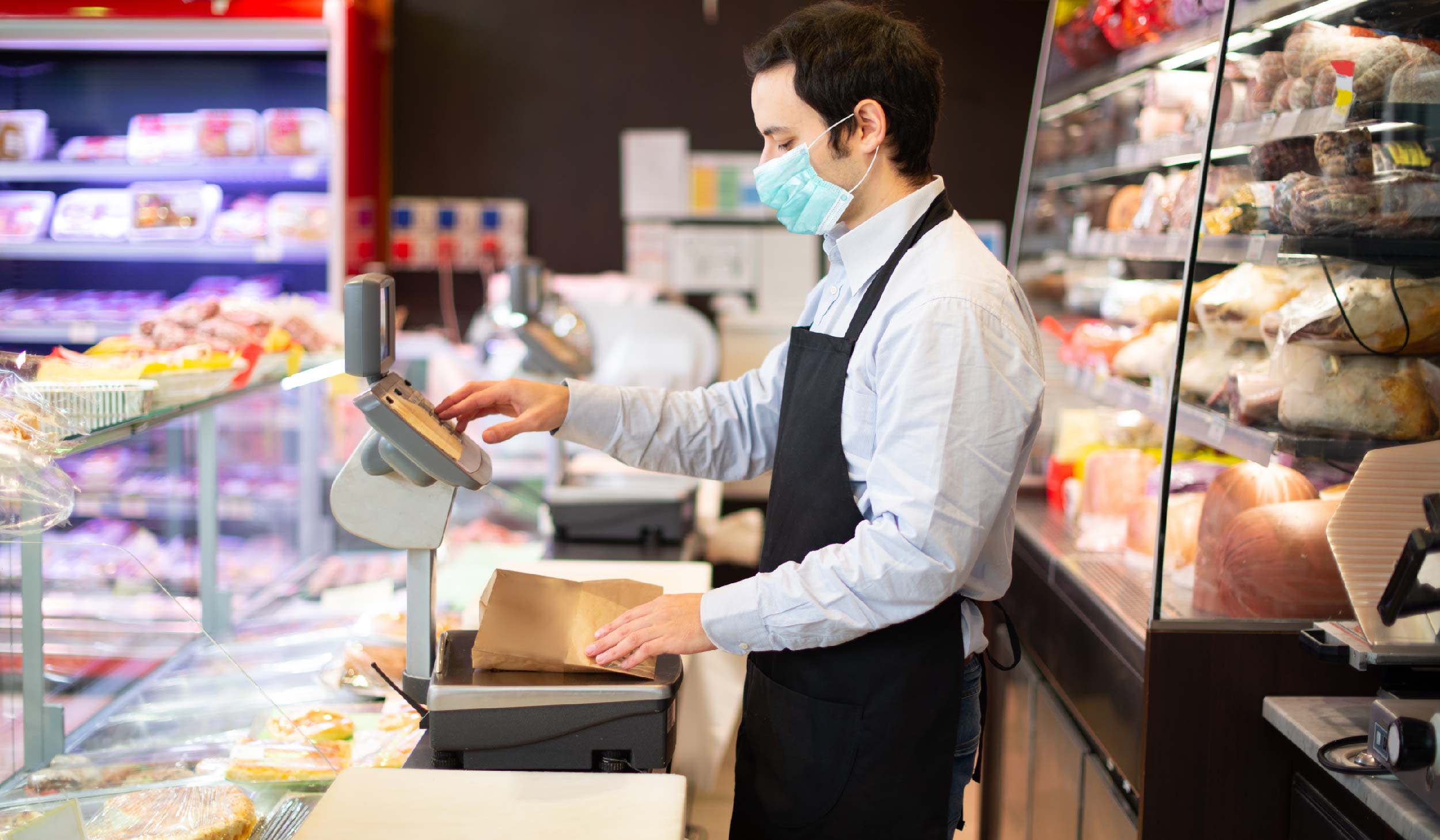
Get More Sales During COVID-19: Think Like a Customer16 min read
In today’s post, we’re examining how customers think. That’s right: we’re going to reveal what they want from you in these difficult times. We’ll be covering the following:
-
The risk that COVID-19 poses to your customers
-
Customer confidence and COVID
-
Food safety during COVID
-
Food safety facts
-
How customers seek to save money when dining out
Throughout, we’ll look at things from the customer’s perspective. This customer-centric view can help you anticipate their needs. That in turn can keep your brand top of mind and can help you edge out the competition.
As you know, every advantage you can gain right now contributes to your survival.
In the News
Before we get to the good stuff, let’s take a quick look at the news.
As usual, Democrats and Republicans are butting heads on how and when to give the American people another stimulus check. The parties have been at loggerheads for months on this issue. Republicans seem to want a standalone bill that would allow a second stimulus check. But Democrats appear unwilling to draft standalone bills. Presumably, this is because they’d have less leverage with which to negotiate for other items. However, the Dems did recently send a standalone airline bailout bill to the Republican-controlled senate, and the senate rejected said bill.
So, at the end of the day, the Dems are trying. Blanket criticism of Democratic leadership as ‘unwilling’ to draft these standalone bills seems a bit short sighted, at best. If not downright dishonest. However, House Speaker Nancy Pelosi has otherwise remained adamant on the bill issue. She wants a broad bill that seeks to tackle more issues at once, and for a much higher price tag than Republicans are willing to entertain.
President Donald Trump seems to want to sign a bill that would authorize the following:
-
Another round of $1,200 stimulus checks
-
$25-billion for the airline industry
-
$135-billion in new small business loans
But precisely when this mystery bill will be proposed and passed remains unclear. The good news: it is likely to be passed…eventually. However, it’s possible that consumers won’t see more relief until after the election.
Meanwhile, economists are warning of dire consequences if the U.S. economy doesn’t receive another shot in the arm in the form of stimulus. Here’s what that means: if consumers fear the worst, they’ll start saving more. If they’re saving more, they’re spending even less. Things can quickly snowball, worsening any existing economic crisis. In a sense, the whole situation can become a self-fulfilling prophecy.
Are Your Customers at Risk?
First, some good news. According to the Centers for Disease Control and Prevention, it’s extraordinarily unlikely that any of your customers would contract COVID-19 from your food. Nor are they likely to contract the disease from food packaging. COVID-19 is an illness of the respiratory tract. That is to say, the respiratory tract is where the virus enters the body and where symptoms manifest.

The primary route of transmission, then, is via respiratory droplets that enter the nose or mouth. Infected individuals can spread these droplets any time they sneeze or cough. There is virtually no evidence of any respiratory virus being transmitted via food or food packaging. So, if a customer expresses concern about the virus spreading this way, you can confidently reassure them. It’s also important to understand that viruses cannot multiply in food. All viruses require a living host for reproduction.
However, as mentioned, viruses can spread from person to person when an infected person sneezes or coughs. This is a cause for concern. It means, of course, that employees can easily transmit the virus to one another. It also means that employees can transmit the virus to customers.
Consequently, if you suspect an employee is sick, you should send them home immediately. Then, you should sanitize their work area thoroughly.
One possible route of transmission in your restaurant is via any non-porous surface, such as metal or ceramic. The virus can remain viable on these surfaces for several hours. If an infected person touches this surface and then rubs their face, nose or eyes, they can become infected. It’s vital, then, that your employees sanitize frequently touched surfaces often. A set cleaning schedule is best. To ensure maximum compliance, create and print a cleaning schedule and compliance sheet.
Your cleaning sheet should have a space for an employee’s signature, the time and the date. Whoever is responsible for cleaning that room signs the sheet every time they do so. This way, you can see if there are any gaps in the cleaning schedule. A reasonable cleaning schedule is every three hours. Don’t forget to tell your employees to sanitize door knobs, grill accessories and cleaning supplies such as mops, brooms and buckets. If you suspect that compliance is low—for instance, that employees are signing the sheet without doing any actual cleaning—ask a manager to check to make sure that the room was actually cleaned.
Did you know? The virus that causes COVID-19 can live on stainless steel for up to 72 hours. On copper, the virus lives for four hours. On cardboard, though, the virus lives for only 24 hours.
In these difficult times, it’s vital that every restaurant does their part to enforce heightened hygiene measures, such as those outlined above. Doing so limits the danger to customers and keeps consumer confidence high. It’s also vital that employees, delivery personnel, managers and owners utilize personal protective equipment—PPE—when on your premises.
Consumer Confidence & COVID
What is customer confidence, and how does it relate to COVID? In a broad sense, customer confidence is an indicator of the faith that customers have in a particular industry. In particular, customers want to know:
-
That a product is reliable
-
That a product is priced fairly
-
That a product is safe to use
-
That a product will be available on an ongoing basis
-
And, more recently, that a product is sourced from renewable sources and/or that it was not unnecessarily tested on animals
So, how does this apply to the restaurant industry specifically?
Think about it: you probably go out to eat all the time. How often do you question whether the food you’re about to eat is safe? If you’re like most people, the answer is, “Not often.” But why is that? After all, in theory, the safest food you can eat is the food you prepare yourself.
When you cook your own food, you take responsibility for cooking meats to a safe temperature. You take responsibility for cleaning fruits and vegetables before consumption. You determine the ingredients you use, and you decide on GMO vs. non-GMO, gluten vs. gluten free, etc. You’re in full control. Yet millions of people around the world choose to eat in restaurants every day.
Despite the fact that eating out comes with concrete risks, such as food poisoning, people choose to eat at restaurants because the restaurant industry enjoys high customer confidence.
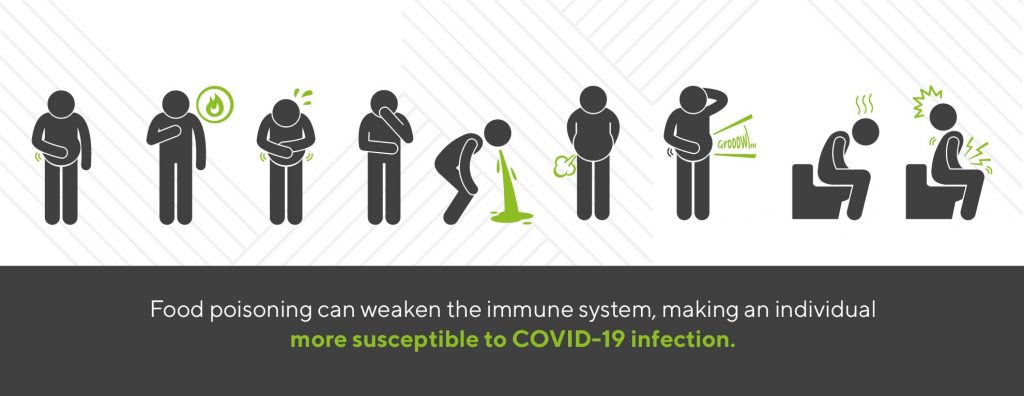
After all, the health of the industry depends on food safety. Food and beverage training programs like ServSafe offer certifications. These certifications signal to consumers that you take their health and safety seriously. And this, in turn, gives them the confidence they need to enjoy a night out without too much worry. There are other factors that contribute to high consumer confidence in the restaurant industry:
-
The FDA and other authoritative bodies ensure that ingredients are safe to use
-
All humans prepare food at some time or another—because meal prep is a universal human experience, consumers are more willing to trust others to be competent at it
-
The causes of food-borne illnesses, such as specific bacteria, are identified and well understood
So, we can see that consumers already have high confidence in the restaurant industry. That’s all well and good, but one of the things that can quickly chip away at consumer confidence is uncertainty.
Uncertainty: In this context, uncertainty mostly pertains to economic status. Consumers may feel uncertain when the stability of the economy is in doubt. However, certain political or societal changes can also contribute to uncertainty.
For instance, many businesses in the UK and Europe have seen lowered consumer confidence because of Brexit. Inflation and wage stagnation can also increase uncertainty.
For our purposes, though, we want to examine how COVID-19 contributes to uncertainty. As we hinted at above, the primary driver is economic in nature. The government is having to bail out airlines. They’re having to send out stimulus checks to millions of citizens. So, many economic analysts are warning that COVID-19 could cause the world economy to go into a downturn.
But that’s not all. The virus that causes COVID crossed over to humans from bats. This means that, technically, such a viral crossover can happen again—pretty much at any time. This fact isn’t widely talked about, because frankly, there’s not much anyone can do. But it is possible that another COVID-like situation could happen.
It’s imperative to do all you can to boost customer confidence. In our next post, we’ll talk more about how to boost customer confidence in more detail. But for now, let’s talk about how to think like a customer.
Food Safety During COVID
Despite high consumer confidence in the restaurant industry, a restaurant is where a consumer is most likely to contract food poisoning. But if you think about it, this makes sense. Unlike a mall that contains several anchor stores, a restaurant is single-purpose operation. So if food poisoning is going to happen anywhere, it’s going to happen most often in restaurants. What’s more, power outages, equipment failures and employee negligence or incompetence can contribute to food spoilage.
But while these things can happen, we all know that they shouldn’t happen.
Any amount of food spoilage eats away at your profit margin. But worse, it can result in illness, which will tarnish your reputation. This in turn threatens your long-term prosperity.
To cut your risk, peruse the below list of basic food safety practices. Then do a quick audit of your own restaurant to ensure you’re in compliance:
-
Store each food or beverage at its ideal temperature—As a rule of thumb, keep cold foods below 40 degrees Fahrenheit and keep hot foods above 140.
-
Inspect your freezers and refrigerators on a regular basis—have walk-in units checked for acceptable ambient temperature and leaks
-
Keep a log that documents temperatures in walk-in freezers and refrigerators
-
Manage inventory with the first-in-first-out model
-
Make sure that all employees are following your food safety protocols—especially if you’ve recently put new or stricter policies in place
-
Have access to and maintain backup power options
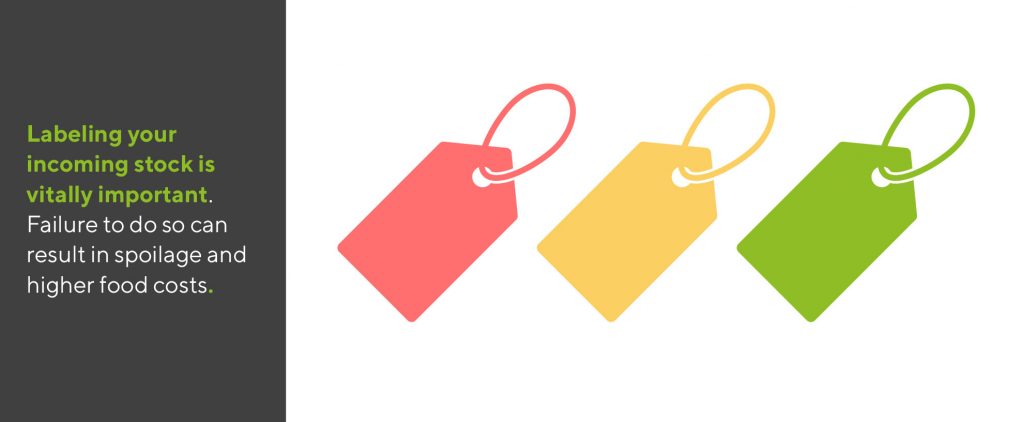
COVID Food Safety Facts From the Consumer’s Perspective
In this section, we’ll look at the advice that goes out to consumers regarding how they should prepare their own food and whether they should eat out. This information is provided by the CDC and other organizations/agencies. We’ll list this information in FAQ format for ease of use. But as you read, keep in mind that this information is consumer facing. Below each question is a section entitled, ‘How to use this information.’ Naturally, this is what’s most relevant to you as an owner/operator.
Can I get COVID-19 from eating fresh foods?
There is no evidence that people can get COVID-19 directly from food. This includes fresh foods like fruits and vegetables. However, it is theoretically possible to contract COVID-19 from eating a fruit or vegetable that an infected person sneezed or coughed on minutes beforehand.
How to use this information:
Encourage or require food-handling employees and servers to wear masks so that they don’t exhale, cough or sneeze on fresh food. Then let customers know about this policy so they’ll feel more at ease.
How should I wash fruits and vegetables?
Wash your hands with soap and water before handling fruits and vegetables. Then wash the item in warm water. There is no special protocol to follow for fresh food prep in the time of COVID.
How to use this information:
Follow your usual food prep procedures. But if customers ask, it’s okay to let them know that you’re taking precautions. Because, well, you are.
Can a person get COVID-19 from eating cooked foods, including animal foods?
There’s no evidence that a person can catch COVID from food per se. Moreover, the virus that causes COVID-19 is killed at the same temperatures that kill harmful bacteria. So cooked meat is not a transmitter of the virus. But again, it’s technically possible that some amount of virus could be on plated food.
How to use this information:
Instruct employees to handle raw and cooked meat products carefully to avoid cross contamination. Again, employees should wear masks so that prepared dishes don’t become contaminated with the virus.
Are grocery stores and food markets safe to go to?
It is safe to go to grocery stores and food markets. However, you should follow certain safety procedures:
-
Wear a mask at all times, especially indoors
-
Clean your hands with hand sanitizer before entering the store
-
Even when wearing a mask, sneeze or cough into your bent elbow
-
Maintain a distance of at least six feet between you and other people
-
Clean your hands thoroughly with soap and warm water when you get home
How to use this information:
There are no confirmed cases of COVID-19 being transmitted via food packaging or food itself. Still, consumers may be concerned about eating out, especially at restaurants. After all, they can’t wear a mask and eat at the same time. So it may be in your best interests to provide sneeze guards and privacy screens at every table if possible. You might also consider providing hand sanitizer.
Is it safe to have groceries delivered?
As long as the store is following solid hygiene procedures, then yes. It is certainly safe to have food delivered. But after you receive a grocery delivery, you should wash your hands thoroughly with soap and warm water.
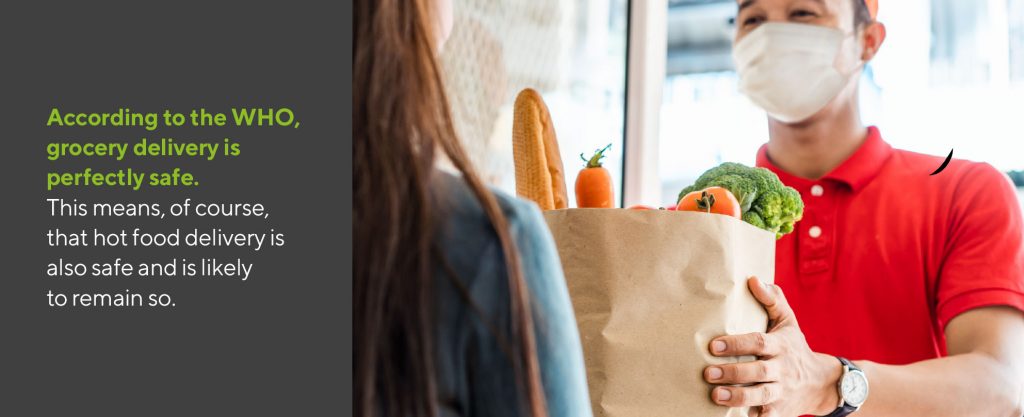
How to use this information:
If consumers are being told that they can have groceries delivered, it stands to reason they want hot food delivered too. Let your customers know about your extra food hygiene and prep precautions. This way, they’ll be confident that you take their health and safety seriously. Your social media accounts are a great way to broadcast this information.
What foods boost the immune system? Which is more important, carb or fat?
Human beings require a wide range of micro-nutrients. Fruits, vegetables and certain animal products—such as organ meats, oysters and mussels—are excellent sources of these nutrients. Dietary fat and protein are very important as these are essential macro-nutrients. Carbohydrate is not an essential macro-nutrient in adults as most people can convert protein into glucose as needed. This is called gluconeogenesis, and it occurs in the liver. If in doubt, consult with your doctor.
There are many vitamins that the body can’t use properly without an adequate supply of dietary fat. Meanwhile, overconsumption of refined sugar can cause inflammation. This can, in time, weaken the immune system as it taxes immune cells.
There is no one food that is proven to prevent or treat COVID-19. Claims that ginger, pepper, tea, garlic or probiotics prevent or treat COVID-19 are unfounded.
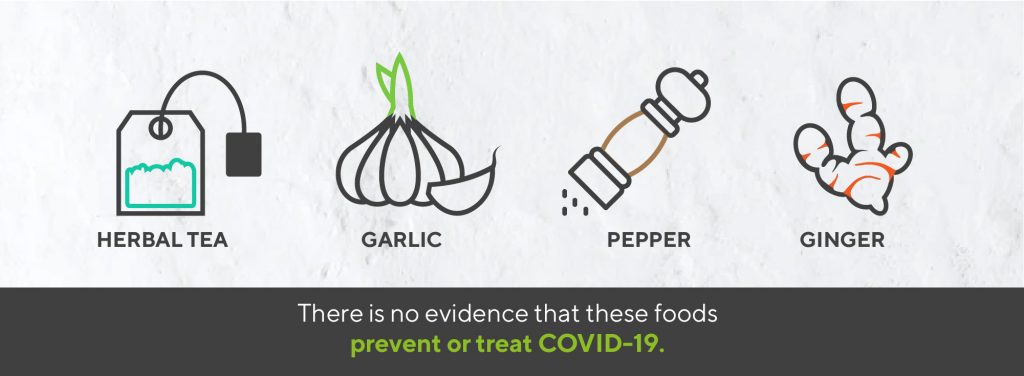
How to use this information:
Let consumers know that your dishes, on the whole, represent a balanced diet. Emphasize dishes that contain healthy fats, such as anything featuring avocado.
Can a multi-vitamin prevent or treat COVID-19?
No. There is no evidence that supplementing with a multi-vitamin prevents or treats COVID.
How to use this information:
Remind customers that your delicious dishes contain healthy foods. These foods are rich in micro-nutrients that can keep them healthy in a general sense. A balanced diet contributes to immune function.
Should I supplement with vitamin D if I can’t get adequate sunlight because of lockdown?
The body produces Vitamin D naturally via exposure to sunlight. If you can get a total of 15 minutes of sunlight throughout the day, you should be in good shape. However, the body can also create vitamin D from fatty foods.
How to use this information:
Any of your dishes that contain fatty animal foods can be a good source of vitamin D. This includes:
-
Fatty fish
-
Fish oils
-
Liver
-
Cheese
-
Yogurt
What is the best disinfectant to use on surfaces?
Cleaners containing .05 sodium hypochlorite are proven effective at rendering the virus harmless. This is a common virucidal ingredient found in many household cleaners.
How to use this information:
Check your cleaning supplies for this ingredient. Then let customers know that you proudly use such cleaners because they’re proven effective at neutralizing the virus that causes COVID-19.
How Consumers Intend to Save
Finally, it’s a good idea to think about how customers try to save money when they eat out. Knowing how the customer thinks can help you create programs that are mutually beneficial. After all, if your customers know they can save some money by doing business with you, they’ll come to you more often. Here are the three biggest ways customers try to save money when dining out.
#1 Ordering Enough to Qualify for Discount or Free Delivery
Amazing Prime and the like have trained many consumers to expect free delivery. Unfortunately, this isn’t viable in the restaurant business. We have to pay drivers to deliver food within a reasonable time frame, and these drivers have their own expenses. Still, consumers look for ways to save money where they can. Consider offering discounted delivery if the customer spends above a certain threshold.

#2 Gift Cards
Consumers love gift cards. This is a good example of a win-win. Gift cards make it easy for your customers to share your food with other people. At the same time, gift cards ensure that the recipient will do business with you. Consumers are on the lookout for special offers right now, too. So take note. For instance, many sites advise customers to look for deals like this:
-
Buy two $25 gift cards and get a third for $10!
A deal like this can be a great way to drum up business if you can afford it.
#3 Membership Clubs
Customers are on the lookout for restaurants that will reward them for their loyalty. When you create your own membership club, you do just that. When customers do enough business with you, they get something in return. The benefit to you is that you effortlessly build brand loyalty.
We hope this post has been a proven a valuable resource! If it has, could you give us a share? Your fellow restaurant owners will appreciate it. Thanks!



